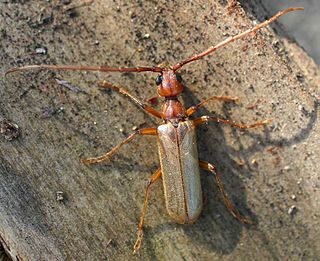
The insects of the beetle family Chrysomelidae are commonly known as leaf beetles, and include over 37,000 species in more than 2,500 genera, making up one of the largest and most commonly encountered of all beetle families. Numerous subfamilies are recognized, but only some of them are listed below. The precise taxonomy and systematics are likely to change with ongoing research.

The longhorn beetles are a cosmopolitan family of beetles, typically characterized by extremely long antennae, which are often as long as or longer than the beetle's body. In various members of the family, however, the antennae are quite short and such species can be difficult to distinguish from related beetle families such as the Chrysomelidae. The family is large, with over 26,000 species described, slightly more than half from the Eastern Hemisphere. Several are serious pests. The larvae, called roundheaded borers, bore into wood, where they can cause extensive damage to either living trees or untreated lumber. A number of species mimic ants, bees, and wasps, though a majority of species are cryptically colored. The rare titan beetle from northeastern South America is often considered the largest insect, with a maximum known body length of just over 16.7 cm (6.6 in). The scientific name of this beetle family goes back to a figure from Greek mythology: after an argument with nymphs, the shepherd Cerambus was transformed into a large beetle with horns.

The Chrysomeloidea are an enormous superfamily of beetles, with tens of thousands of species, mostly in the families Cerambycidae and Chrysomelidae, the leaf beetles.
Francis Polkinghorne Pascoe was an English entomologist mainly interested in Coleoptera, commonly known as beetles.

Powderpost beetles are a group of seventy species of woodboring beetles classified in the insect subfamily Lyctinae. These beetles, along with spider beetles, death watch beetles, common furniture beetles, skin beetles, and others, make up the superfamily Bostrichoidea. While most woodborers have a large prothorax, powderpost beetles do not, making their heads more visible. In addition to this, their antennae have two-jointed clubs. They are considered pests and attack deciduous trees, over time reducing the wood to a powdery dust. The damage caused by longhorn beetles is often confused with that of powderpost beetles, but the two groups are unrelated. The larvae of the Cerambycidae are white, straight and generally flat-headed, whereas those of the Bostrichidae are white and C-shaped.

Per Olof Christopher Aurivillius was a Swedish entomologist.

Chahuis or xamoes are the common names given in Mexico to a variety of edible beetles within the insect order Coleoptera. The insects' common names in English are often "sticks worms", "rhinoceros beetle," or "grub".
Julius Weise was a German entomologist. He specialised in Coleoptera, especially Chrysomelidae and Coccinellidae, and was one of the first entomologists to use genitalia to identify and classify species.

Lamiinae, commonly called flat-faced longhorns, are a subfamily of the longhorn beetle family (Cerambycidae). The subfamily includes over 750 genera, rivaled in diversity within the family only by the subfamily Cerambycinae.

Macrodontia is an American genus of long-horned beetles remarkable for their large size and for the large mandibles of the males in particular.

The Disteniidae are a small family of beetles in the superfamily Chrysomeloidea, traditionally treated as a group within the Cerambycidae.

The Oxypeltidae are a small family belonging to the superfamily Chrysomeloidea, widespread in the Andean region of Chile and Argentina. They have traditionally been considered a group within the Cerambycidae.

The Vesperidae are a small family of beetles, normally classified within the family Cerambycidae, of heterogeneous aspect but all characterised by larval stages related to roots of herbaceous plants or trees

Cerambycinae is a subfamily of the longhorn beetle family (Cerambycidae). The subfamily includes over 715 genera, which, in total, consist of some 3,900 species. The subfamily is most widely distributed in the Americas, with 430 species in 130 genera in its neotropical regions. Within the family, the only subfamily of comparable diversity is the Lamiinae.

Stephan von Breuning was an Austrian entomologist who specialised in Coleoptera, particularly Cerambycidae.
Acmaeopsoides rufula is a species of beetle in the family Cerambycidae, and the only species in the genus Acmaeopsoides. This beetle is distributed in Canada, and United States.

Callidium is a genus of beetles in the family Cerambycidae, containing the following species:
Lepturgantes is a genus of beetles in the family Cerambycidae, containing the following species:

Colobothea is a genus of longhorn beetles of the subfamily Lamiinae.
Dmytro Zajciw was a Ukrainian and Brazilian entomologist, notable for his collection and for his many beetle discoveries. He was the author of Two new genera and species of neotropical Longhorn beetles , 1957, Contribution to the study of Longhorn beetles of Rio de Janeiro , 1958, and was the first to describe the genera Adesmoides and Pseudogrammopsis, as well as the species Beraba angusticollis and Mionochroma subaurosum, among many others.















